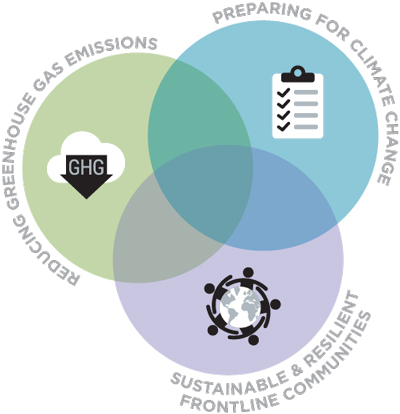Confronting climate change
Tackling climate change is a priority for the Wastewater Treatment Division (WTD). We are working to reduce greenhouse gas emissions, support sustainable and resilient frontline communities, and prepare our wastewater system for the changing climate.
King County’s Strategic Climate Action Plan guides WTD’s work on climate change.

Reducing greenhouse gas emissions
Greenhouse gasses are the primary cause of recent climate change. Most of the greenhouse gasses in King County come from transportation and energy use. The Wastewater Treatment Division is the largest electricity user of all King County government. It takes a lot of energy to pump and treat the wastewater from 1.9 million people every day.
WTD is taking actions like these to reduce greenhouse gas emissions:
- Reduce energy use
- Produce renewable energy – turn digester gas to energy.
- Offer Sewer Heat Recovery (SHR) for heating or cooling buildings.
- Use Loop® biosolids to build soil and plant trees to keep carbon dioxide out of the atmosphere. Soil and plant uptake of carbon are proven solutions for sequestering carbon.
- Follow sustainable building practices. WTD’s Georgetown Wet Weather Treatment Station Project achieved Envision Platinum certification.
Sustainable and resilient frontline communities
WTD operates 24/7 to ensure all of our ratepayers have access to healthy, viable waterways, regardless of their income, race, or neighborhood. WTD is taking actions like these to support sustainable and resilient frontline communities:
- Study our system to see if there are inequities in our practices between neighborhoods across the service area.
- Look for opportunities to improve equity with each new project.
Preparing for a changing climate
WTD needs to plan for wetter winters, drier summers, wildfire smoke, sea-level rise and other effects of climate change.
Here’s what WTD is doing to prepare for climate change:
- Analyze how climate change could affect the wastewater system
- Identify WTD facilities that are at risk of being impacted by sea level rise
- Evaluate the magnitude, frequency, and timing of coastal flooding in shoreline areas that are important to WTD
- Assess the impacts of changing precipitation patterns and storm intensities on the WTD system
- Identify sources of saltwater intrusion
- Explore how increased rainfall will affect the size of facilities we need to control combined sewer overflows.
- Make the wastewater system more robust
- Develop guidance to include climate change considerations when we build sewer projects.
- Improve power reliability at West Point Treatment Plant. South Plant and Brightwater have multiple power feeds/alternative energy sources.
- Train employees to manage heat exposure and smoke so they can continue to do their work safely.
- Create more local customers for our recycled products.
- Recycled water can help customers manage droughts
- Developing local customers for biosolids can make it easier to deliver biosolids during more severe winter storms.
Technical studies underway
Resources
Visit Software Help if you have trouble viewing or downloading documents.
- CSO Climate Change Preparedness, December 2021
This report documents what WTD learned from other wastewater utilities about how they were adapting their combined sewer overflow (CSO) programs for climate change. WTD will use what it learned to prepare for and adapt its CSO system for climate change. - Modeling of Possible Future Climate Change Scenarios, October 2021
King County used models to learn how increasing rainfall in future years – 2070-2099 – might affect the combined sewer overflow (CSO) system. The models show that the system will need to manage 40-54% more CSO volume to meet current regulations. - Sea Level Rise Assets Report, September 2021
This report identifies the King County assets like roads, treatment plants, airport that are most at risk due to sea level rise. - Hydraulic analysis of effects of sea-level rise on King County's wastewater system, November 2012 (1.4MB)
- Saltwater intrusion and infiltration into the King County wastewater system, March 2011 (6.5MB)

 Translate
Translate